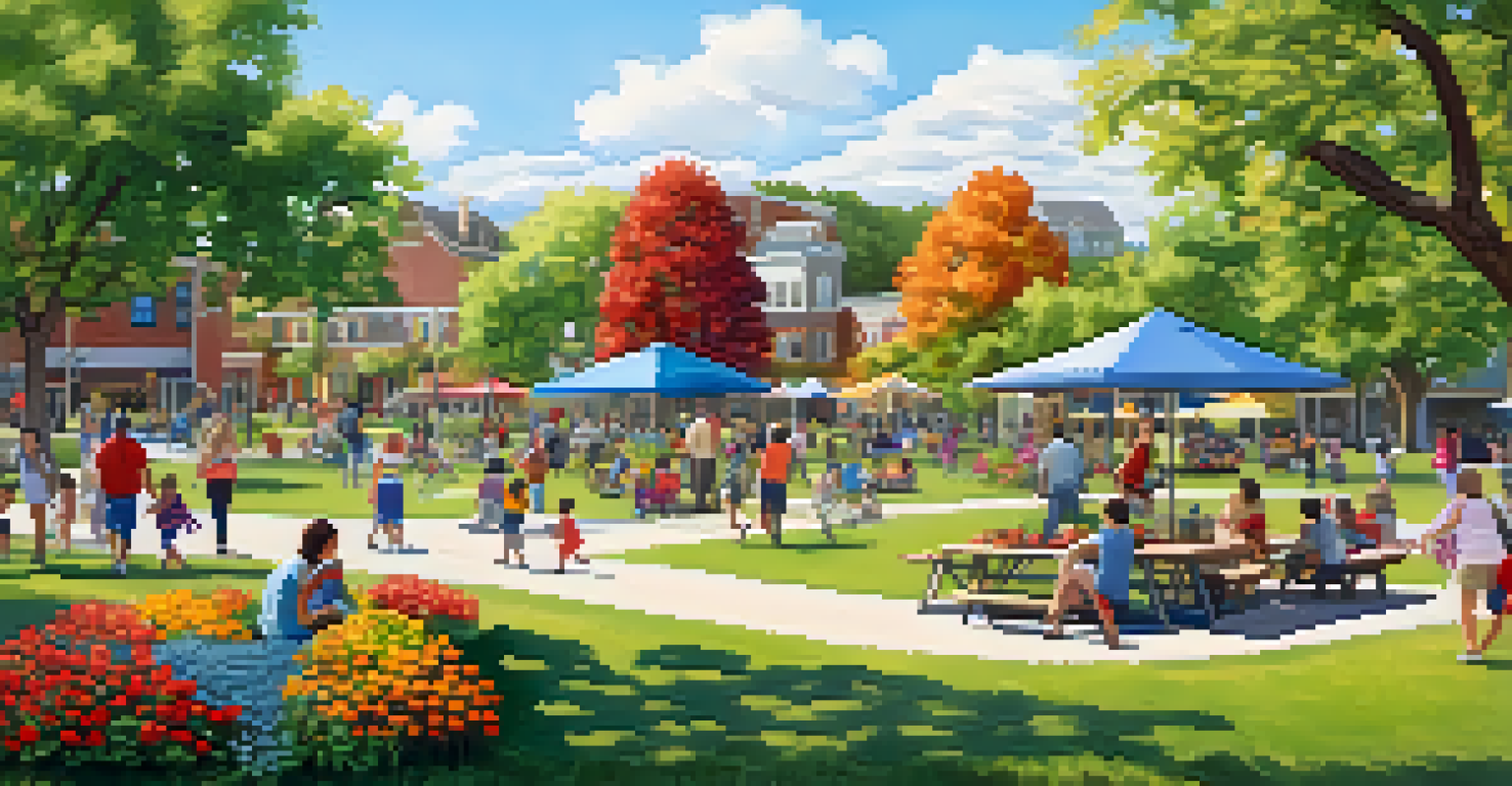Gentrification in Phoenix: Trends and Community Impacts

Understanding Gentrification: A Brief Overview
Gentrification is a complex process that often begins with urban revitalization. It typically involves an influx of wealthier residents into lower-income neighborhoods, which can lead to rising property values and rents. While this transformation can improve local infrastructure and services, it often displaces long-standing residents. Essentially, gentrification is a double-edged sword, bringing both opportunities and challenges to communities.
Gentrification is a double-edged sword, bringing both opportunities and challenges to communities.
The phenomenon is not unique to Phoenix; cities across the U.S. have experienced similar shifts. In Phoenix, areas like Downtown and Roosevelt Row have seen significant changes as new businesses and residential developments sprout up. This urban renewal is frequently driven by a desire for trendy places to live and work, appealing to younger demographics and professionals. Understanding these dynamics is crucial for grasping the broader implications for the community.
As we dive deeper into Phoenix's gentrification trends, we will explore the factors fueling this change and its varied impacts. From economic development to cultural shifts, the story of gentrification in Phoenix is multifaceted. By examining these elements, we can better appreciate the nuances of urban transformation in this vibrant city.
Current Gentrification Trends in Phoenix
In recent years, Phoenix has experienced a notable uptick in gentrification, particularly in neighborhoods like Garfield and the Eastlake Park area. These communities have seen an influx of new residents, leading to a significant rise in property values. This trend is often fueled by the city's overall growth, as more people move to Phoenix seeking affordable housing and a warm climate.

The local economy also plays a significant role in these gentrification trends. As tech companies and startups establish themselves in Phoenix, they attract a younger workforce. This demographic shift encourages a demand for modern housing and amenities, further driving up property prices and changing the neighborhood landscape. It's a cycle that seems to be gaining momentum, with no signs of slowing down.
Gentrification's Dual Impact
Gentrification brings both opportunities for urban improvement and challenges such as displacement of long-standing residents.
Additionally, the city’s focus on revitalizing urban spaces has led to increased investment in infrastructure and public amenities. While this can enhance the quality of life for many, it raises concerns about the effects on long-term residents who may find themselves priced out. As we continue to explore this topic, it’s essential to recognize how these trends impact the very fabric of Phoenix’s diverse communities.
The Role of Local Government in Gentrification
Local government plays a pivotal role in the gentrification process, influencing policies that can either mitigate or exacerbate the effects of urban development. In Phoenix, initiatives aimed at improving public transportation and infrastructure often attract new businesses and residents. However, these developments can also lead to rising costs that displace existing community members.
Listening to community voices is essential for understanding the real impact of gentrification.
Zoning laws and land-use policies are key factors in this equation. By altering regulations to allow for new types of development, local governments can encourage gentrification. While these changes may spur economic growth, they can also transform the character of neighborhoods, leading to tensions between newcomers and long-standing residents.
Moreover, community engagement is crucial in shaping how gentrification unfolds. Local governments that prioritize input from residents can better balance development with the needs of existing communities. This collaborative approach can help ensure that the benefits of urban renewal are shared more equitably, fostering a sense of belonging for all residents.
Community Voices: Perspectives on Gentrification
Listening to community voices is essential for understanding the real impact of gentrification. Many long-time residents share concerns about losing their homes and cultural identity as neighborhoods change. Their stories often highlight the emotional toll of displacement, which can fracture community ties built over decades.
Conversely, newer residents may view gentrification as a positive transformation, bringing in better amenities, improved safety, and a vibrant local economy. This divide can create a sense of conflict, as different groups have varying access to resources and power in shaping their neighborhoods. Finding common ground is essential for fostering unity amidst change.
Economic Effects of Gentrification
While rising property values can boost local economies, they often lead to loss of affordable housing for low-income families.
Community organizations play a critical role in amplifying these voices and advocating for equitable solutions. By promoting dialogue and collaboration between different stakeholders, they can help bridge the gap between residents and newcomers. Ultimately, prioritizing community perspectives is vital to ensuring that gentrification benefits everyone, not just a select few.
Economic Impacts of Gentrification in Phoenix
The economic impacts of gentrification are often felt in both positive and negative ways. On one hand, rising property values can boost local tax revenues, which can fund public services and infrastructure improvements. This can lead to better schools, parks, and community amenities that benefit all residents.
However, the downside is that increased property values and rents can push out low-income families, leading to a loss of affordable housing options. This creates a ripple effect, as those displaced may struggle to find housing elsewhere, often relocating to areas further from their jobs or support networks. The economic benefits of gentrification can thus come at a steep cost to certain community members.
Moreover, as neighborhoods gentrify, local businesses may thrive initially but could also face challenges. Long-standing businesses that cater to the original community may find it difficult to compete with new establishments targeting wealthier customers. This can lead to a loss of cultural identity in neighborhoods that once thrived on their unique character and history.
Social and Cultural Changes Due to Gentrification
Gentrification not only reshapes the economic landscape but also brings about significant social and cultural changes. As new residents move in, they often bring different lifestyles, values, and preferences. This cultural shift can enhance diversity but may also lead to tensions over issues like public space usage and community traditions.
For example, local events that once celebrated the neighborhood's heritage may change or even disappear, replaced by newer activities that cater to the tastes of newcomers. This shift can alienate long-time residents who feel their culture is being overshadowed. Balancing these diverse cultural expressions is crucial for fostering an inclusive community.
Community Perspectives Matter
Understanding the diverse voices within a community is essential for addressing the complex social and cultural impacts of gentrification.
Moreover, the social fabric of neighborhoods can be altered, as gentrification often leads to demographic changes that impact everything from schools to local governance. To navigate these challenges, communities must prioritize inclusivity and seek opportunities for collaboration. By embracing both new and old traditions, neighborhoods can create a rich tapestry that reflects their evolving identity.
Strategies for Managing Gentrification Effects
Managing the effects of gentrification requires a multifaceted approach that prioritizes community well-being. Strategies may include implementing affordable housing initiatives, such as rent control or subsidies for low-income families. These measures can help ensure that long-time residents can remain in their homes despite rising costs.
Community land trusts are another effective strategy, allowing residents to collectively own and manage land. This model can help preserve affordable housing and prevent displacement by removing properties from the speculative market. Such innovative solutions empower communities and create sustainable development.

Furthermore, fostering community engagement is essential in developing policies that reflect the needs of all residents. Initiatives that encourage dialogue, such as town hall meetings or workshops, can help bridge the divide between newcomers and long-standing residents. By working together, communities can create a shared vision for their neighborhoods that respects both history and progress.